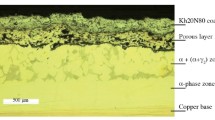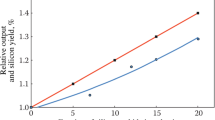Conclusions
Investigation have been made on development of the production parameters for silicon carbide refractories from SiC, C, and Si. It has been shown that high quality parts are obtained with firing and cooling of the refractories in two gaseous media providing synthesis of a combined binder and high properties. The parts produced are used for protection of blast furnace tuyere noses.
Similar content being viewed by others
References
Ya. Inamura, Refractories and Their Use [in Russian], Metallurgiya, Moscow (1984).
P. H. Haveranek, “Alkali attack in blast furnace refractories,” Trans. J. Brit. Ceram. Soc.,77, No. 3, 92–97 (1978).
J. T. Kanynebyrg and J. Larr, “Silicon carbide: a new material for the blast furnace stack,” Iron Steel Eng.,53, No. 6, 57–60 (1976).
N. Nameishi, “Gegenwartiger Stand auf dem Gebiet der feuerfesten baustoffe für die Eisen- und Stahlindustrie in Japan,” Tonind.-Ztg.,101, No. 5/6, 149–172 (1977).
A. M. Gavrish, A. B. Puchkov, I. L. Boyarina, et al., “Formation of sialon in the Si3N4-Al2O3-AlN system,” Ogneupory, No. 8, 28–29 (1988).
S. A. Wild, “A novel route for the production ofβ′-sialon powders,” J. Mater. Sci.,11, No. 10, 142–174 (1976).
J. L. Huang, A. C. Hurford, R. A. Cutter, et al., “Sintering behavior and properties of sialon ceramics,” J. Mater. Sci.,21, No. 4, 1448–1456 (1986).
T. Hirota, T. Higashihara, and T. Kawakami, “The service high-temperature conditions of silicon carbide refractories of a low part of blast furnace stack,” Interceram.,32, 43–47 (1983).
A. S. Berezhnoi, “The relationship between pressing pressure and porosity of unfired refractory parts,” Ogneupory, No. 3, 124–130 (1947).
I. S. Kainarskii, “The technology, properties, and use of high-density dinas,” in: Collected Scientific Works of the All-Union Scientific-Research Institute for Refractories [in Russian], Vol. I (XLVIII), Metallurgizdat, Moscow (1956), pp. 229–275.
I. S. Kainarskii and É. V. Degtyareva, Carborundum Refractories [in Russian], Metallurgizdat, Moscow (1963).
E. V. Degtyareva, “Compaction of carborundum compounds,” Byul. Nauch. Tekh. Inst. Ukr. Nauch.-Issled. Inst. Ogneuporov, Metallurgizdat, Khar'kov, No. 5, 77–84 (1959).
Author information
Authors and Affiliations
Additional information
Translated from Ogneupory, No. 11, pp. 25–28, November, 1993.
Rights and permissions
About this article
Cite this article
Pitak, N.V., Fedoruk, R.M. & Degtyareva, L.M. Silicon carbide parts for protection of blast furnace tuyere noses. Refractories 34, 570–574 (1993). https://doi.org/10.1007/BF01292740
Issue Date:
DOI: https://doi.org/10.1007/BF01292740




